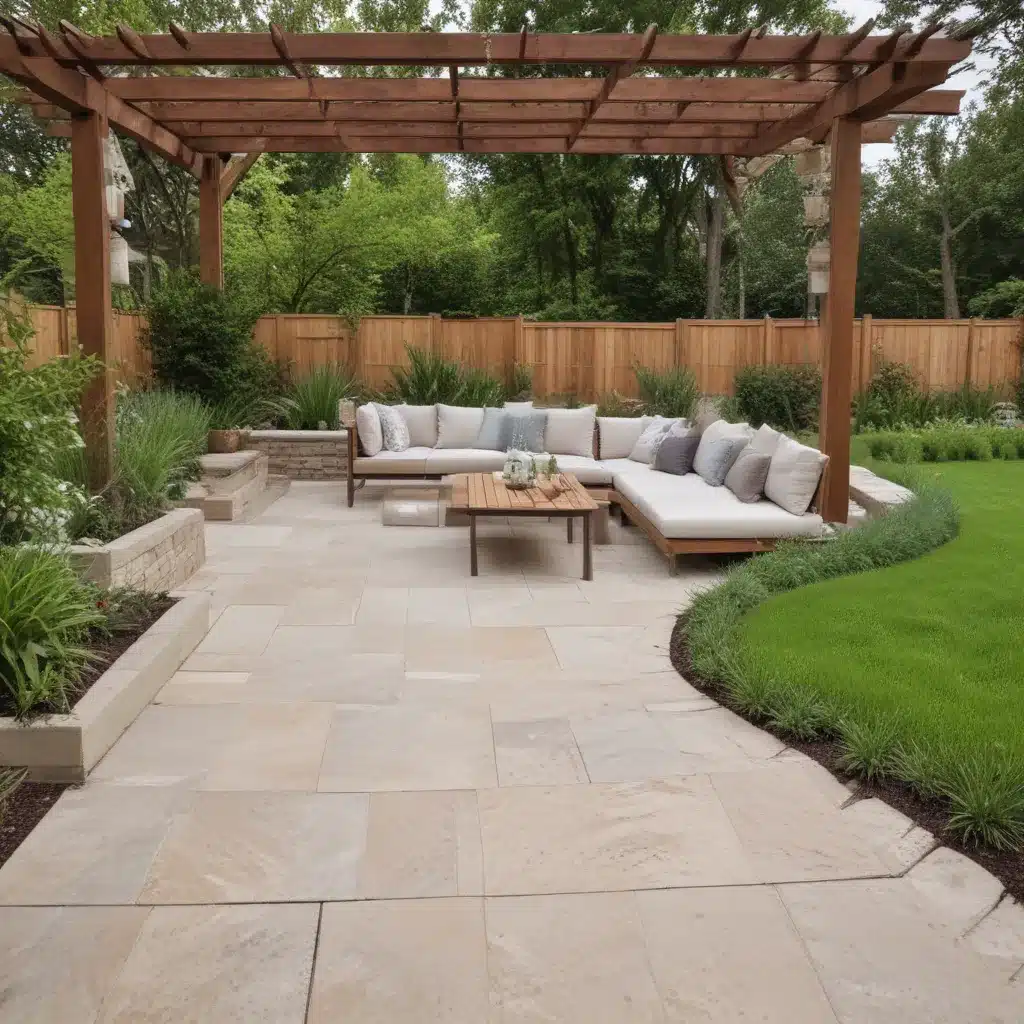
As an experienced outdoor living consultant, I’ve witnessed the growing demand for eco-friendly patio solutions that minimize environmental impact. Homeowners today are increasingly mindful of their choices, seeking patio designs and landscaping that align with their sustainability values. At Cincinnati Patiopaving, we’re dedicated to guiding you through the process of creating a beautiful, environmentally-conscious outdoor living space.
Patio Paving Trends
Permeable Paving Solutions
Traditional impermeable paving materials like concrete and asphalt can contribute to stormwater runoff, disrupting natural water cycles and overwhelming municipal drainage systems. In contrast, permeable paving solutions like porous pavers, permeable concrete, or gravel allow water to infiltrate the ground, recharging aquifers and reducing the risk of flooding. These innovative materials not only enhance the aesthetics of your patio but also actively promote groundwater recharge and reduce the strain on local infrastructure.
Recycled and Repurposed Materials
Sustainability-minded homeowners are increasingly gravitating toward patio materials made from recycled or repurposed resources. Recycled concrete, for example, can be crushed and used as a base for new patio installations, diverting waste from landfills. Reclaimed brick, natural stone, and even recycled plastic pavers offer visually appealing and eco-friendly alternatives to virgin materials.
Natural Stone and Pavers
Natural stone and pavers made from materials like slate, flagstone, or travertine are not only long-lasting and durable but also inherently sustainable. These materials are quarried from the earth, require minimal processing, and can be seamlessly integrated into a variety of outdoor living designs. By choosing natural stone, you can create a patio that is both beautiful and environmentally conscious.
Outdoor Design Ideas
Integrating Native Plants
Incorporating native plants into your patio landscaping is a simple yet effective way to promote biodiversity and support local ecosystems. Native species are adapted to the local climate and soil conditions, requiring less water, fertilizer, and maintenance than non-native alternatives. By creating habitats for pollinators and other wildlife, you can enhance the ecological value of your outdoor living space.
Incorporating Rainwater Harvesting
Collecting and repurposing rainwater is an excellent way to reduce your patio’s environmental impact. Rainwater harvesting systems, such as underground cisterns or above-ground rain barrels, allow you to store precipitation for irrigation or other non-potable uses, minimizing the demand on municipal water supplies.
Maximizing Shaded Areas
Strategically placing trees, pergolas, or shade structures can help reduce the need for energy-intensive cooling solutions like air conditioning. Shaded areas not only create a more comfortable outdoor environment but also help mitigate the urban heat island effect, which can contribute to increased energy consumption and greenhouse gas emissions.
Installation Techniques
Minimizing Soil Disturbance
When preparing the site for your patio, it’s essential to employ installation techniques that minimize soil disturbance. Limiting excavation and preserving the existing topsoil can help maintain the natural integrity of the site, reducing erosion and supporting healthy soil ecosystems.
Ensuring Proper Drainage
Proper drainage is crucial for the longevity and performance of your patio. Thoughtful drainage design, which may include French drains, swales, or permeable surfaces, helps prevent pooling, reduces the risk of damage, and ensures the efficient management of stormwater runoff.
Optimizing Material Efficiency
By carefully planning the layout and using precise measurements, you can optimize the use of patio materials, reducing waste and minimizing the environmental impact of your project. Our experienced team works diligently to minimize material offcuts and ensure that every resource is utilized to its fullest potential.
Maintenance Guidelines
Eco-Friendly Cleaning Methods
Maintaining your patio doesn’t have to come at the expense of the environment. Eco-friendly cleaning products and techniques, such as natural vinegar-based solutions or biodegradable degreasers, can keep your patio looking its best while avoiding the use of harsh chemicals that can harm local waterways and ecosystems.
Promoting Longevity and Durability
Investing in high-quality, durable patio materials and proper installation can extend the lifespan of your outdoor living space, reducing the need for frequent replacements. Prioritizing longevity not only saves you money in the long run but also minimizes the environmental impact associated with material production and disposal.
Minimizing Environmental Impact
Regular maintenance is essential for preserving the beauty and functionality of your patio, but it’s also crucial to consider the environmental implications. By adopting sustainable practices, such as using hand tools, minimizing water usage, and properly disposing of waste, you can ensure that your patio maintenance routine aligns with your eco-conscious values.
Cost Comparisons
Initial Investment Considerations
While eco-friendly patio solutions may have a slightly higher upfront cost compared to traditional options, the long-term benefits often outweigh the initial investment. Permeable pavers, recycled materials, and natural stone, for example, may carry a higher price tag, but their durability, low-maintenance requirements, and environmental advantages make them a worthwhile choice for many homeowners.
Long-Term Operational Savings
Sustainable patio designs can also translate into significant operational cost savings over time. Features like rainwater harvesting systems and energy-efficient shading can reduce your utility bills and minimize the need for resource-intensive maintenance, providing a return on your initial investment.
Factoring in Eco-Benefits
When considering the cost of your patio project, it’s essential to factor in the environmental and societal benefits of sustainable design. By choosing eco-friendly materials and techniques, you contribute to the preservation of natural resources, the reduction of greenhouse gas emissions, and the overall enhancement of your local ecosystem. These intangible but invaluable benefits can play a crucial role in your decision-making process.
As you embark on creating your dream outdoor living space, prioritizing sustainability and environmental consciousness is a wise investment that will pay dividends for years to come. At Cincinnati Patiopaving, we’re committed to guiding you towards patio solutions that not only elevate the visual appeal of your property but also minimize your carbon footprint and contribute to a healthier, more sustainable future.

